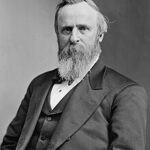The Hayes Railroad Strike Decision
President Rutherford B. Hayes faced America’s first nationwide labor crisis in July 1877. Railroad companies had slashed worker wages by 10% amid economic depression. Workers across multiple states launched coordinated strikes in response. Hayes made the controversial decision to deploy federal troops against American workers. ⚠️ This marked the first time federal military force was used to break a labor strike.
Federal Military Intervention
Hayes authorized troops in West Virginia, Maryland, Pennsylvania, and Illinois. The president claimed he was restoring order and protecting interstate commerce. Railroad executives had pressured government officials for military intervention. Federal soldiers confronted striking workers in major cities like Pittsburgh and Baltimore. 🚂 The Hayes Railroad Strike suppression established a dangerous precedent for future labor disputes.
Immediate Consequences
Violence erupted as federal troops clashed with workers and supporters. Over 100 people died during the confrontations nationwide. Property damage exceeded millions of dollars in today’s currency. 💰 Railroad companies resumed operations under military protection. Workers returned to reduced wages without gaining any concessions from their employers.
Impact:
Labor Relations Transformation
The Hayes Railroad Strike suppression fundamentally altered American labor-government relationships. Workers lost trust in federal institutions that sided with corporate interests. Labor unions began organizing more aggressively to counter government-business alliances. 🔥 The precedent encouraged future presidents to use military force against striking workers. This decision marked the beginning of systematic federal opposition to organized labor.
Economic and Political Fallout
Corporate America gained confidence in government support during labor disputes. Railroad companies continued wage cuts knowing federal protection was available. Hayes faced criticism from working-class voters and labor sympathizers. 📉 The decision contributed to growing wealth inequality in the Gilded Age. Political divisions between pro-business Republicans and pro-labor Democrats deepened significantly.
Long-term Historical Consequences
Federal military intervention became standard practice in major labor conflicts. The Pullman Strike of 1894 and other disputes followed similar patterns. American workers developed lasting distrust of federal government neutrality. 🌍 International observers noted America’s harsh treatment of labor compared to European nations. The precedent influenced anti-union policies well into the 20th century.
